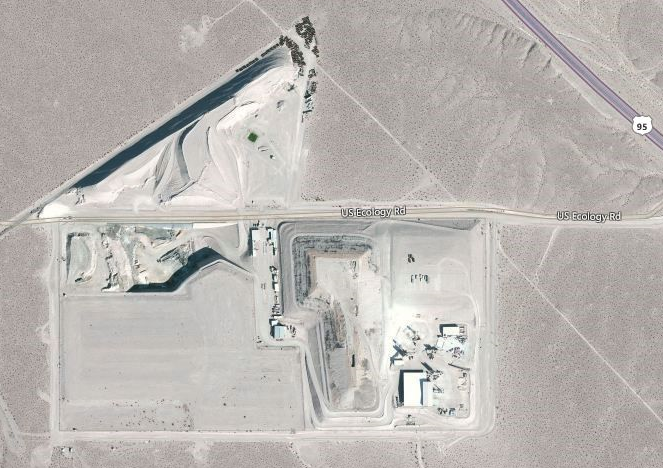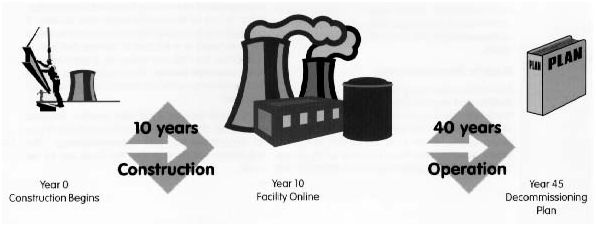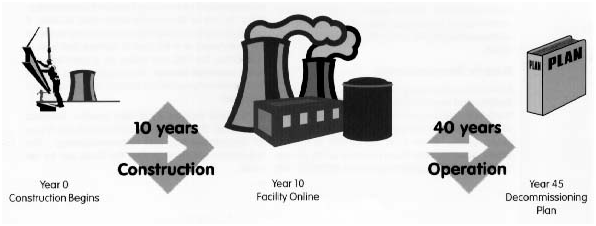
Blog
-
Geiger Readings for Oct 30, 2015
Ambient office = 112 nanosieverts per hourAmbient outside = 99 nanosieverts per hourSoil exposed to rain water = 85 nanosieverts per hourRomaine lettuce from Central Market = 101 nanosieverts per hourTap water = 130 nanosieverts per hourFiltered water = 118 nanosieverts per hour -
Radioactive Waste 153 – Fire and Explosions At Nevada Nuclear Waste Dump
A company called U.S. Ecology Inc. (formerly called Nuclear Engineering Co.) maintained a dump for radioactive wastes near Beatty, Nevada about a hundred miles northwest of Las Vegas for decades. The dump was opened in 1962 as the first federally licensed low-level radioactive waste dump. Contaminated tools and laboratory equipment, protective clothing, machine parts, medical isotopes and other materials from nuclear reactors were accepted by the dump. The dump also received other hazardous waste including chemicals and old transformers containing polychlorinated biphenyls. Twenty two trenches were dug on the site up to one hundred feet deep and eight hundred feet long. They were capped with up to ten feet of clay and dirt.
The dump had been plagued by many problems such as leaky shipments and staff taking contaminated tools and building materials out of the dump for personal use. The operating license for the dump was temporarily suspended in the 1970s for the mishandling of shipments. Federal documents indicate that forty million seven hundred thousand cubic feet of radioactive materials were buried at the dump before 1992 when the dump was closed. The Federal government mandated that individual states had to maintain their own nuclear waste dumps or use dumps maintained by an association of states. The company lost its license and had to close the dump. The dump was part of eighty acres that were turned over to the state in 1997 to be administered by the Nevada Department of Health and Human Services.
On Sunday, October 18, there was an underground fire in Trench 14 of the dump. Trench 14 is a pit in which containers of low-level radioactive waste were buried. White smoke poured out of the ground and then multiple underground explosions occurred which spewed more smoke and debris in the air, leaving a crater twenty feet by thirty feet. Water and heavily corroded fifty five gallon metal drums were found in the crater. Debris from the blast was spread almost two hundred feet. Several metal drums were found outside of the facility fence.
Nevada authorities are not sure exactly what is in Trench 14 that caught fire but they said that it burned “very hot.” Gamma radiation detectors were flown over the site but did not record elevated levels of radiation. Radiation detectors were carried up to the edge of the location of the fire and explosions by National Guard soldiers wearing protective gear to see if heavier radioactive particles had been blown out of the hole but also recorded no abnormal radiation. There is some concern that recent wet weather might have caused water to penetrate the ground. State records of the contents of the site are being checked to see if any known contents of Trench 14 could have reacted with water to cause the fire and explosions.
The state was supposed to be monitoring and maintaining the dump but investigative reporters found out that the state legislature took five hundred thousand dollars out of the fund for monitoring and risk mitigation at the Beatty dump and put it in the general fund to help balance the state budget. Despite the fire and explosions and the withdrawal of funds by the legislature, the state lawmakers insist that the site monitoring fund is sufficient. My question is sufficient for what? This is a chronically troubled site that just suffered an accident that might have been prevented. I suggest the Nevada legislature restore the pilfered money and choose a less dangerous way to balance the state budget.
Old U.S. Ecology nuclear waste dump, ten miles southeast of Beatty, Nevada:
Bing Maps
-
Radiation News Roundup Oct 29, 2015
Former World Health Organization official says that the Fukushima plant is dumping nuclear waste into ocean on a daily basis, there is no foreseeable end to it and nobody has any good ideas on how to stop it. enenews.com
Robot star illuminates human themes in Japanese nuclear disaster film news.yahoo.com
A services organization in Britain with its roots in maritime regulations, engineering and science, Lloyd’s Register Energy, said it had signed an agreement with the Nuclear Power Institute of China (NPIC) to assist with the development of a floating small modular reactor (SMR). nuclearstreet.com
-
Geiger Readings for Oct 29, 2015
Ambient office = 127 nanosieverts per hourAmbient outside = 82 nanosieverts per hourSoil exposed to rain water = 88 nanosieverts per hourVine ripened tomato from Central Market = 119 nanosieverts per hourTap water = 110 nanosieverts per hourFiltered water = 94 nanosieverts per hour -
Radioactive Waste 152- Decommissioning and Spent Nuclear Fuel – Part Two of Two Parts
Part Two of Two Parts (Please read Part One first.)
Money was collected from ratepayers who used nuclear power for the purpose of eventually dismantling old reactors, removing radioactive components and materials and restoring the land where the reactors had been located. That money was never intended to be used to pay for the indefinite storage of spent nuclear fuel rods on the site of the reactors but that is what is happening as the decommissioning funds are being raided.
Critics of temporary onsite spent fuel storage point out that while nuclear power plants are located near bodies of water that is use for cooling the reactors, spent nuclear fuel is best stored as far away from bodies of water as possible to prevent possible contamination in case that storage containers leak. Storing spent fuel in stable underground repositories is best.
Because of the failure of the U.S. government to complete the promised underground repository at Yucca Mountain as mentioned above, nuclear plant owners have resorted to redesigning the racks in cooling pools to accommodate more rods. It has been estimated that all the cooling pools for spent nuclear fuel in the U.S. will be full within five years unless some of the rods are removed.
The only choice for external storage without a permanent repository is to construct concrete and steel dry casks on site or at a central interim facility to contain the spent fuel. There are nuclear plant locations where the plant was decommissioned and removed decades ago but dry casks with spent fuel rods still remain and are guarded twenty four hours a day, seven days a week, three hundred and sixty five days a year. Some plants have been mothballed for up to sixty years in the hopes that there will be money available for decommissioning by then.
Vermont is the only state in the U.S. which is trying to prevent the raiding of decommissioning funds to build dry casks for temporary storage of spent fuel. Just recently, Vermont received a ruling from a NRC board that Entergy, the company that operates a nuclear power plant in Vermont, will have to notify the state government of any withdrawals from the decommissioning fund and exactly what the money is used for.
The nuclear industry is adamant that the blame for the raiding of decommissioning funds should not be placed on the industry, the NRC or even the Department of Energy. They say that the U.S. Congress is responsible for the current situation because it has failed to create the promised permanent underground repository. This is an interesting situation because the nuclear industry has “captured” the NRC and gets away with a lot of violations of regulations. They have spent millions in lobbying Congress but have not succeeded in get Congress to move forward swiftly in the creation of a permanent repository. The reason that they have failed is that there is great fear among the public of radioactive waste and for good reason.
The industry and the U.S. government have a horrible record of dealing with radioactive waste. Local political pressure has made it difficult for the U.S. government to find a site willing to host a permanent spent nuclear fuel repository. And every story about nuclear accidents makes the public more reluctant. Alternative sustainable energy should replace nuclear power as quickly as possible. We cannot even properly dispose of the spent nuclear fuel rods that exist. We should not be make and use more.
-
Radiation News Roundup Oct 28, 2015
In this video Luke Rudkowski and Tim Pool give you a brief recap of their trip inside the Fukushima exclusion zone that is still closed down. youtube.com
Did TEPCO Make Workers Go Into Dangerous Radiation Areas? fukuleaks.org
Republicans are looking for a side door to open the nuclear waste dump at Yucca Mountain in Nevada, after President Obama scrapped the project in his first term. washingtonexaminer.com
-
Geiger Readings for Oct 28, 2015
Ambient office = 135 nanosieverts per hourAmbient outside = 110 nanosieverts per hourSoil exposed to rain water = 119 nanosieverts per hourAvocado from Central Market = 111 nanosieverts per hourTap water = 108 nanosieverts per hourFiltered water = 97 nanosieverts per hour -
Radioactive Waste 151 – Decommissioning and Spent Nuclear Fuel – Part One of Two Parts
Part One of Two Parts
As I have mentioned before in previous blog posts, I am very concerned about the decommissioning of closed nuclear reactors. Decommissioning is a complex and expensive process. The reactor has to be disassembled and the pieces properly disposed of. The U.S. has about a hundred operating nuclear power reactors. All of them will reach the end of their licensed life-spans within the next few decades. A few have already been shut down because they were getting too expensive to repair and maintain or because they could not compete in the energy market.
The Nuclear Regulatory Commission requires the owners of all nuclear power plants to have sufficient funds set aside for decommissioning. Owners of about twenty percent of the operating nuclear power reactors in the U.S. do not have sufficient funds set aside and are being pressured by the NRC. Some of the set aside funds are invested in stocks. If the stock market crashes again, those funds could be wiped out. If a company that owns and operates nuclear power reactors goes bankrupt, presumably it would be up to the tax payers to come up with sufficient funds to decommission closed reactors.
If time comes to decommission a nuclear power reactor and the funds are not available, then it might just be boarded up and fenced off until money does become available. Given the desperate financial situation of the state and federal governments these days and the dire predictions of coming crises, such mothballed plants could sit there for decades without being decommissioned. Radioactive materials could leak out over time, severe weather could breach the containment or terrorists could deliberately loot or destroy the boarded up plants.
The U.S. government has been making nuclear power plant operators pay into a fund intended to support the construction and operation of a permanent geological repository for spent nuclear fuel. The repository was promised by 1999 but after decades of work, the Yucca Mountain nuclear repository project was cancelled in 2009. It is now estimated that there will be no such repository before 2050. At its peak, the fund had around thirty billion dollars. Some of the nuclear power reactors owners have begun to use lawsuits to claw back some of the funds donated.
The law supporting the waste disposal fund was written specifically to exclude the use of such funds for temporary spent nuclear fuel. There has been pressure to change those rules to allow some of the waste fund to be used for that purpose. Recently, some owners have been using some of the money set aside for decommissioning to create dry casks storage for their spent nuclear fuel at the reactors sites. Although this does violate NRC regulations, the NRC has granted exemptions to every owner that has requested permission. An NRC spokesperson said, “All of the plants that have permanently shut down in recent years have sought, and been approved for, the use of decommissioning funds for spent fuel storage costs.”
Please read Part Two
-
Geiger Readings for Oct 27, 2015
Ambient office = 118 nanosieverts per hourAmbient outside = 135 nanosieverts per hourSoil exposed to rain water = 129 nanosieverts per hourCrimini mushroom from Central Market = 77 nanosieverts per hourTap water = 97 nanosieverts per hourFiltered water = 89 nanosieverts per hour






